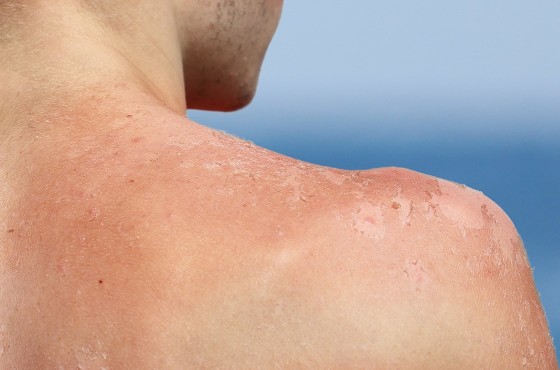Why and how should you protect yourself from the dangers of the sun?
Written by Paul Musset, Doctor in Pharmacy | published on | updated on 16/06/2022

The sun offers many benefits. A natural supplier of vitamin D and a morale booster, it is actively sought after by many British people who impatiently wait for the summer to take advantage of it. Its virtues are well known, yet the sun can also prove harmful to your health. What are its dangers? How does the skin naturally protect itself from the sun? What are the most effective prevention means?
The dangers of the sun and ultraviolet for your skin
UVA, UVB, UVC: how to differentiate between them?
The sun's rays are divided into three categories:
- UVA: they account for 95% of the UV radiation passing through the ozone layer. They cause skin aging;
- UVB: they only represent 5% of the radiation, yet they are very energetic (powerful in energy) and responsible for sunburns;
- UVC: they are very dangerous and are blocked by the ozone layer.
Why is the sun dangerous: what risks do you take when exposing yourself?
The consequences on sight
The repeated and prolonged exposure of your eyes to the sun could prove harmful. UV rays act cumulatively: the more ultraviolet rays the eyes receive, the higher the risk of developing an eye disease (as a cataract, for instance).
Blue or green eyes are more sensitive to light. True or false?
False. In reality, the color of your eyes is only obtained by their upper layer, i.e. the iris. However, there is a lower layer found at the level of the retina. The pigmentation of the latter (which we do not see since it is hidden by the iris) protects the eye from light. The color of these pigments is the same for all eyes. What makes the difference in terms of sensitivity is the quantity and distribution of these pigments. The fewer there are, the more the eye – whether blue, green or brown – is sensitive to light.
Sunstrokes are hazardous to your organism
Sunstrokes are caused by prolonged exposure to the sun during the strongest radiation time of the day. They cause the body to suffer from hyperthermia with the latter no longer managing to regulate itself naturally. Perspiration is blocked and can no longer dissipate excess heat. Sunstrokes lead to headaches, nauseas, vomiting and muscle pains. In the most serious situations, a sunstroke can even be fatal.
Children and seniors are the groups that are the most prone to heatstroke.
To remedy this dangerous condition, it is imperative to lower the body temperature (by cooling down, hydrating, sitting in the shade...).
The risks for your skin
First-degree burn: sunburn
Getting a sunburn is the most frequent risk triggered by a prolonged exposure to the sun. Indeed, UVB is very energetic and, in high season, a few minutes are enough for the skin to get a first-degree burn. This type of sunburn results in intense redness in the skin.
Premature aging of the skin
The UVA are responsible for it. Indeed, their radiation penetrates the epidermis and forms free radicals that attack the collagen fibers that are responsible for skin elasticity and tone. The latter dries out more easily and promotes the formation of wrinkles.
Skin cancer
This is without a doubt the most serious consequence of your skin getting too much sun. Two types of skin cancer can largely be caused by the sun: carcinoma and melanoma.
Skin cancer in figures:
- Skin cancer is the 5th most common cancer in the UK;
- About 16 200 skin cancer cases are diagnosed each year in the UK;
- 90% of skin cancers are carcinomas;
- The sun is responsible for over 65% of skin melanomas (the most dangerous cancer).
The defense mechanisms of your skin against the sun
How does the skin protect itself from the sun?
The skin defends itself from external aggressions using melanin, a dark pigment produced by specific cells called melanocytes. When the skin is exposed, melanin rises to the level of the upper layers of the epidermis to create a protective barrier. The latter gives a tanned complexion to the skin.
Your level of melanin is not unlimited. Indeed, our skin holds a certain level of sun resistance. Once our reserves are exhausted, the epidermis no longer benefits from natural defenses.
What are the most fragile skin types?
All skin types – including black skin types – are sensitive to the sun. However, fair skins have a lower melanin level than dark skins and therefore have fewer defenses against the harmful effects of ultraviolet light.
Children's skin – should it be light or dark – is also particularly fragile, because its top layer is still very thin and lets UVB rays (which cause sunburn) penetrate more easily. In addition, a child who is regularly sunburned is more likely to develop skin cancer.
Avoiding the dangers of the sun: prevention and reaction
When should you protect your skin from the sun?
In the UK, it is imperative to protect your skin from the sun when the solar radiation is most intense, i.e. from May to September.
Moreover, a bright sun is not the only risky factor during this period. Even in gray weather, ultraviolet rays can penetrate through clouds and be harmful.
How to protect yourself from ultraviolet light?
The regular application of a suitable sunscreen on your skin remains the most effective way to create a barrier of protection against the sun. At Cocooncenter, we offer a range of sun protection products from leader brands.
The epidermis is not the only area of ??your body you should take care of. To avoid the risk of suffering from sunstroke, you should also protect your head with a hat and drink regularly.
A few good habits to enjoy the summer safely
To prevent your vacation from being ruined by a sunburn or sunstroke, here are a few recommendations to follow:
- Avoid exposure at the hottest hours of the day (i.e. between 12 p.m. and 4 p.m.);
- Regularly renew the application of sunscreen;
- Protect children using full equipment (hat, sunglasses, T-shirt).
How to treat a sunburn?
To treat a sunburn, it is necessary to apply a sunburn-soothing cream. This will help your skin to repair itself and avoid the appearance of blisters. Cocooncenter offers you various effective remedies for sunburns.
Skin cancer screening
If in doubt about a mole or simply if you have suffered from several sunburns, skin cancer screening can be carried out by a dermatologist.
UV Index: identifying the intensity of the sun
A UV index system has been implemented so that you identify the level of intensity of ultraviolet rays. It is made of 5 different indexes:
• 1 to 2: weak;
• 3 to 5: moderate;
• 6 to 7: strong;
• 8 to 10: very strong;
• 11: extreme.
Despite all its benefits, the sun presents numerous dangers. Properly protecting yourself from its radiation – both on the skin and body levels – is essential to preserve your health.
Three key points to remember about the dangers of the sun:
- UVB rays are the most dangerous for your health; they are responsible for sunburn and the majority of cancers linked to repeated and unprotected exposure to the sun;
- Children’s skin is particularly sensitive to the harmful effects of the sun; repeated sunburns during childhood increase the risk of developing skin cancer;
- With no sun protection, a few minutes of exposure are enough to get a sunburn.



















